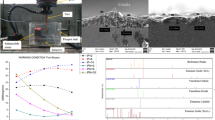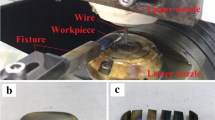Abstract
This study explores the feasibility of removing the recast layer formed on aluminum alloy cylindrical specimens machined by wire electrical discharge machining (WEDM) by using magnetic abrasive finishing (MAF). The WEDM is a thermal machining process capable of accurately machining parts with high hardness or complex shapes. The sparks produced during the WEDM process melt the metal’s surface. The molten material undergoes ultra-rapid quenching and forms a layer on the surface defined as recast layer. The recast layer may be full of craters and microcracks which reduce service life of materials tremendously, especially under fatigue loads in corrosive environments. This investigation demonstrates that MAF process, can improve the quality of WEDM machined surfaces effectively by removing the recast layer. The present work studies the effect of some parameters, i.e., linear speed, working gap, abrasive particle size, and finishing time on surface roughness and recast layer thickness using full factorial analysis. Three-level full factorial technique is used as design of experiments for studying the selected factors. In order to indicate the significant factors, the analysis of variance has been used. In addition, an equation based on regression analysis is presented to indicate the relationship between surface roughness and recast layer thickness of cylindrical specimens and finishing parameters. Experimental results show the influence of MAF process on recast layer removal and surface roughness improvement.
Similar content being viewed by others
References
Ho KH, Newman ST, Rahimifard S, Allen RD (2004) State of the art in wire electrical discharge machining (WEDM). Int J Mach Tools Manuf 44:1247–1259
Shobert EI (1983) What happens in EDM. In: Jameson EC (ed) Electrical discharge machining: tooling, methods and applications. SME, Dearbern, pp 3–4
Tsai HC, Yan BH, Huang FY (2003) EDM performance of Cr/ Cu-based composite electrodes. Int J Mach Tools Manuf 43(3):245–252
Boothroyd G, Winston AK (1989) Non-conventional machining processes. Fundamentals of machining. Marcel Dekker, New York, p 491
McGeough JA (1988) Electrodischarge machining. Advanced methods of machining. Chapman & Hall, London, p 130
Lim LC, Lee LC, Wong YS, Lu HH (1991) Solidification microstructure of electro-discharge machined surfaces of tool steels. Mater Sci Technol 3(7):239–248
Lee LC, Lim LC, Narayanan V, Venkatesh VC (1988) Quantification of surface damage of tool steels after EDM. Int J Mach Tool Manuf 28(4):359–372
Liao YS, Huang JT, Chen YH (2004) A study to achieve a fine surface finish in wire-EDM. J Mater Process Technol 149:165–171
Jain VK (2004) Advanced machining processes. Allied, New Delhi
Singh DK, Jain VK, Raghuram V (2006) Experimental investigations into forces acting during a magnetic abrasive finishing process. Int J Adv Manuf Technol 30:652–662
Girma B, Joshi SS, Raghuram MVGS, Balasubramaniam R (2006) An experimental analysis of magnetic abrasives finishing of plane surfaces. Mach Sci Technol 10(3):323–340
Yan BH, Chang GW, Cheng TJ, Hsu RT (2003) Electrolytic magnetic abrasive finishing. Int J Mach Tool Manuf 43:1355–1366
El-Taweel TA (2008) Modelling and analysis of hybrid electrochemical turning magnetic abrasive finishing of 6061 Al/Al2O3 composite. Int J Adv Manuf Technol 37:705–714
Kim J, Choi M (1997) Development of the magnetoelectrolytic abrasive polishing system (MEAPS) and finishing characteristics of a Cr-coated roller. Int J Mach Tool Manuf 37:997–1006
Shinmura T, Takazawa K, Hatano E (1990) Study on magnetic abrasive finishing. Ann ICRP 39:325–328
Lin CT, Yang LD, Chow HM (2007) Study of magnetic abrasive finishing in free-form surface operations using the Taguchi method. Int J Adv Manuf Technol 34:122–130
Kim J-D, Noh I-H (2007) Magnetic polishing of three dimensional die and mold surfaces. Int J Adv Manuf Technol 33(1–2):18–23
Wang CC, Chow HM, Yang LD, Lu CD (2009) Recast layer removal after electrical discharge machining via Taguchi analysis: a feasibility study. J Mater Process Technol 209:4134–4140
Schumacher BM (1990) About the role of debris in the gap during electrical discharge machining. Ann ICRP 39(1):197–199
Yamaguchi H, Shinmura T, Kaneko T (1996) Development of a new internal finishing process applying magnetic abrasive finishing by use of pole rotation system. Int J Japan Soc Prec Eng 30(4):317–322
Givi M, Fadaei Tehrani A, Mohammadi A (2011) Polishing of the aluminum sheets with magnetic abrasive finishing method. Int J Adv Manuf Technol. doi:10.1007/s00170-011-3753-0
Yamaguchi H, Shinmura T (2000) Study of an internal magnetic abrasive finishing using a pole rotation system. Prec Eng 24:237–244
Altenpohl DG (1998) Aluminum, technology, applications, and environment. A profile of a modern metal, 6th edn. Warrendale, TMS, pp 360–364
Troeger LP, Starke EA (2000) Microstructural and mechanical characterization of a superplastic 6xxx aluminum alloy. Mater Sci Eng 277(1–2):102–113
Montgomery DC (2000) Design and analysis of experiments. Wiley, New York
Author information
Authors and Affiliations
Corresponding author
Rights and permissions
About this article
Cite this article
Khalaj Amineh, S., Fadaei Tehrani, A. & Mohammadi, A. Improving the surface quality in wire electrical discharge machined specimens by removing the recast layer using magnetic abrasive finishing method. Int J Adv Manuf Technol 66, 1793–1803 (2013). https://doi.org/10.1007/s00170-012-4459-7
Received:
Accepted:
Published:
Issue Date:
DOI: https://doi.org/10.1007/s00170-012-4459-7




